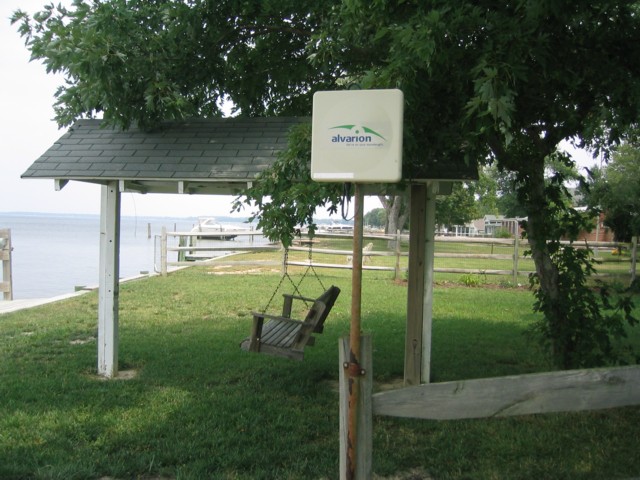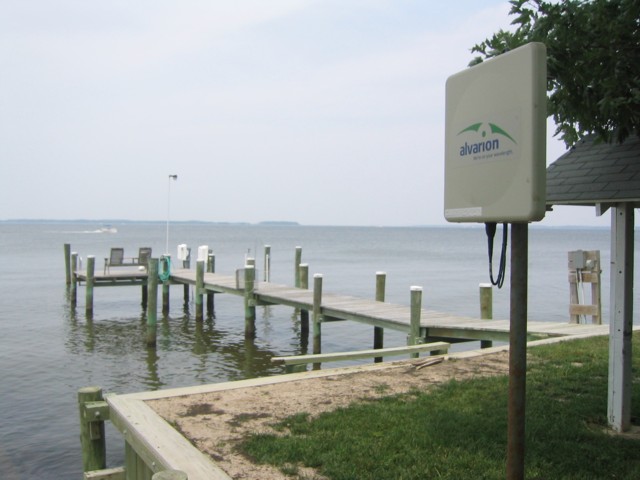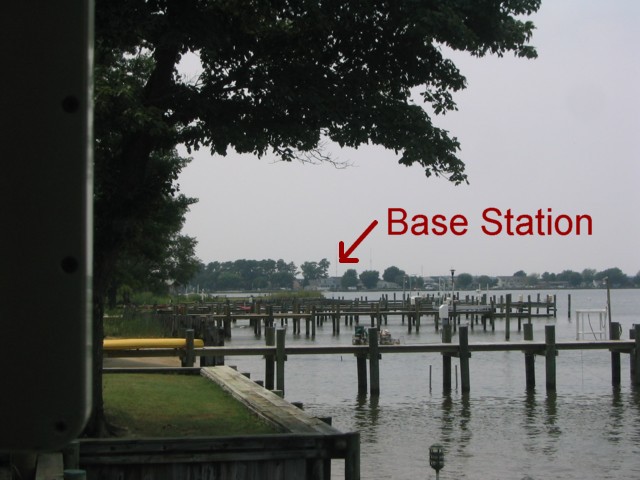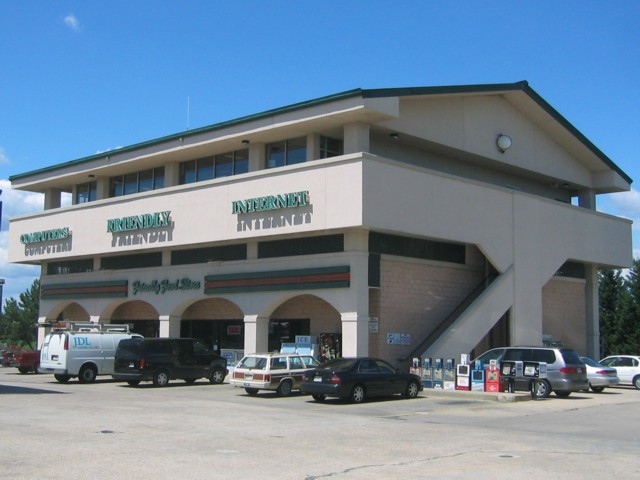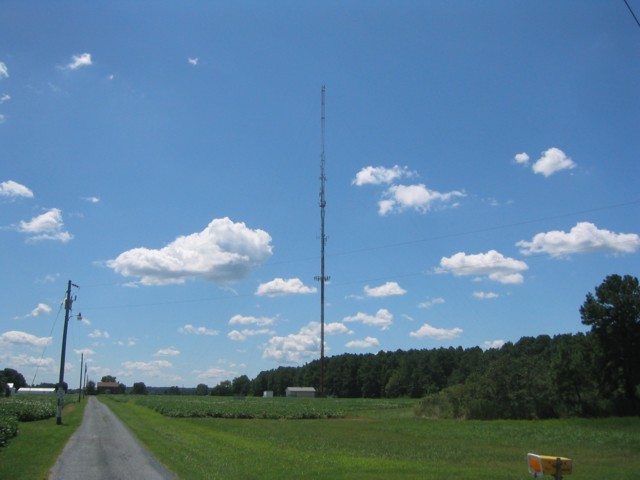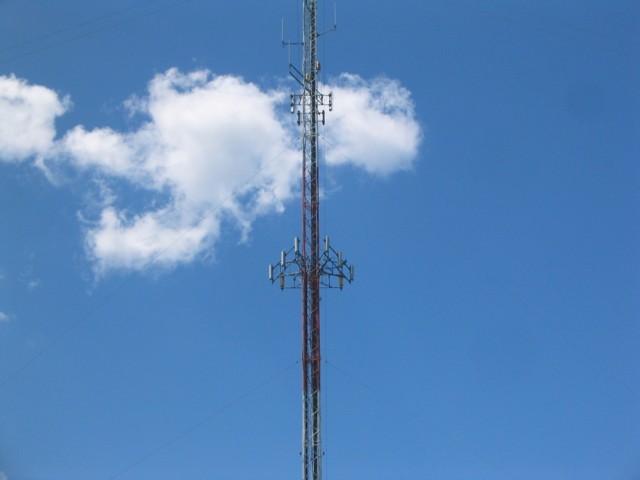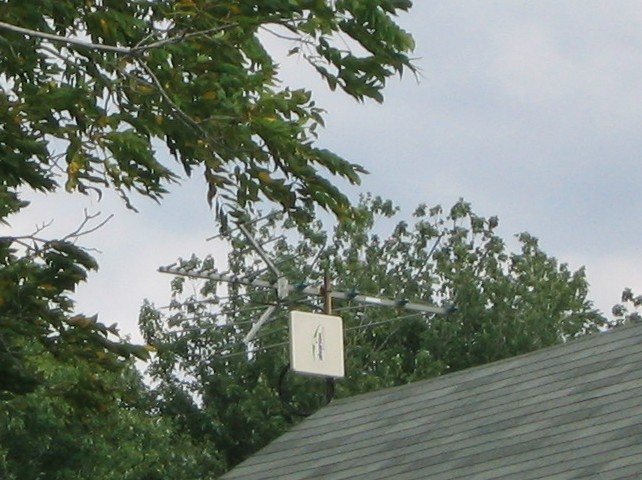Out here in
Grasonville although in the center
of the first English settlement in America some four hundred years ago, amongst
many large marinas and with route 50, a busy three lane highway connecting
Washington DC to the beaches of
Ocean City going right I first applied for service, there was some debate about
whether I had a
direct line of sight to the base station from my property. I first applied for service, there was some debate about
whether I had a
direct line of sight to the base station from my property.
 Looking from the
street or the house there is no way, but from
the bulkhead at the very bottom of my garden, there is a clear view across the
water, so the antenna is installed on a pole bolted to the fence post by the bulkhead. Any place will do to mount the antenna as it is quite weather proof.
In my installation, it is common for the waves splashing against the bulkhead to
come up and wash right over it! Other (probably more suitable)
locations would be on the roof, bolted to a chimney or in the loft if the signal
is strong enough. Also the location should be in a place where inquisitive
people won't stand right in front of it. The FCC says 26 inches away is
safe but I don't recommend being that Looking from the
street or the house there is no way, but from
the bulkhead at the very bottom of my garden, there is a clear view across the
water, so the antenna is installed on a pole bolted to the fence post by the bulkhead. Any place will do to mount the antenna as it is quite weather proof.
In my installation, it is common for the waves splashing against the bulkhead to
come up and wash right over it! Other (probably more suitable)
locations would be on the roof, bolted to a chimney or in the loft if the signal
is strong enough. Also the location should be in a place where inquisitive
people won't stand right in front of it. The FCC says 26 inches away is
safe but I don't recommend being that close! The antenna then connects to the radio by a long coaxial
cable, about 50 feet in length. In my case, the cable runs in a conduit
behind the bulkhead, then under the grass from the center of the bulkhead up to
the house. The radio then just sits on the floor under the
sub woofer of my stereo. Again, the
radio is quite impervious to the elements and could even have been mounted under
the house in the crawl space. Then a CAT5 cable runs under the house from
the radio to a
D-Link DI-704P residential gateway in my office, which then connects to all
the computers and cameras etc. When the radio is powered up, it hunts for the
base station and the particular transceiver in the array that it will
communicate with. Once that is complete, there is a Wan light on the radio
that comes on to show that it is working ok. There is also a signal
strength meter under the antenna. This can show red, amber & green with a
level to show the signal strength. Mine always shows all green which is as
good as it gets. close! The antenna then connects to the radio by a long coaxial
cable, about 50 feet in length. In my case, the cable runs in a conduit
behind the bulkhead, then under the grass from the center of the bulkhead up to
the house. The radio then just sits on the floor under the
sub woofer of my stereo. Again, the
radio is quite impervious to the elements and could even have been mounted under
the house in the crawl space. Then a CAT5 cable runs under the house from
the radio to a
D-Link DI-704P residential gateway in my office, which then connects to all
the computers and cameras etc. When the radio is powered up, it hunts for the
base station and the particular transceiver in the array that it will
communicate with. Once that is complete, there is a Wan light on the radio
that comes on to show that it is working ok. There is also a signal
strength meter under the antenna. This can show red, amber & green with a
level to show the signal strength. Mine always shows all green which is as
good as it gets.In case there is no direct line of sight, there
is now new hardware available that is more powerful and has a greater range, but
the initial cost of the hardware is higher. Back in the Cloudburst days,
the hardware was leased as part of the service contract and that is how mine
still is. Now however, to get service you need to buy your own gear.
Checkout the
wireless internet access page at
Friendly Networks
to find out about the latest plans. I have 256kbps upload and 512kbps
download for $59.99 a month. I also have a public IP address so that I can
access my WebCams from the internet for
which they charge about $14.95. Again you should check with
Friendly Networks
to get proper pricing information. When the service was first connected,
they let me have full bandwidth for a week or so to make sure everything was
working. The speed was over 3000kbps! I wonder how I can get some
more of that? Anyhow, with still nothing else to compare, the 256/512 is
working out fine for me. Not as fast as DSL or cable but still perfectly
adequate to allow me to work from home which is the most important thing.
Over the last two years there have been no interruptions to the service worthy
of any comment. Sometimes I have noticed odd interruptions, but by the
time I go and check the WAN light on the radio, it's working again!
|

